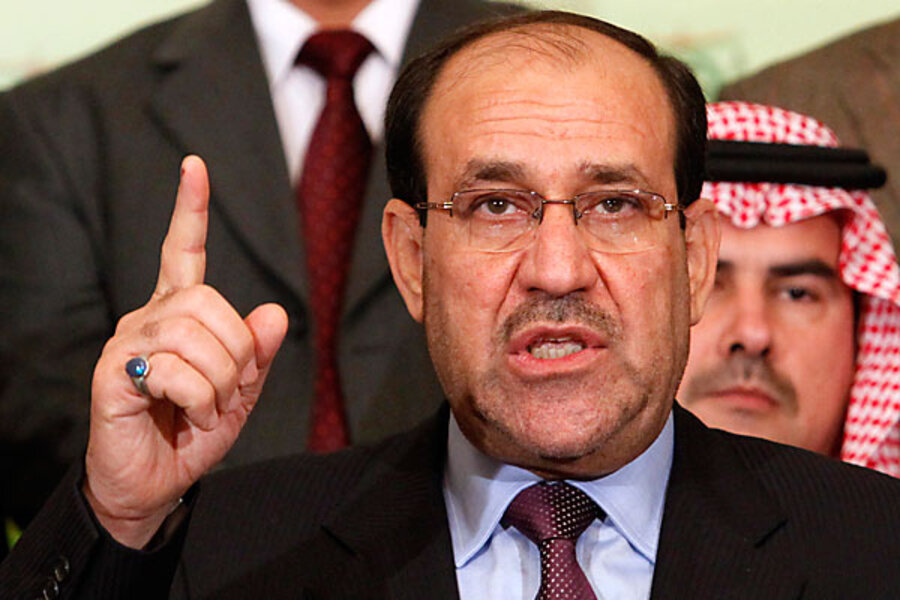Two Iraq Al Qaeda leaders killed: Did they really get Abu Omar al-Baghdadi?
| Baghdad
The death of a top Al Qaeda in Iraq (AQI) leader could sever a link between Al Qaeda headquarters and its Iraqi offshoot but the identity of a second figure previously announced to have been killed appears far from clear.
Iraqi Prime Minister Nouri al-Maliki on Monday announced that Iraqi and US forces had killed Abu Omar al-Baghdadi and Abu Ayyub al-Masri, an Egyptian believed to have ties to Al Qaeda leadership, in a rocket attack on their safe house in northern Iraq on Sunday. At the time of the killing of Al Qaeda in Iraq leader Abu Musab al-Zarqawi in 2006, US officials said he had been replaced by Mr. Masri, who they said had fought and trained with the group in Afghanistan prior to the US invasion of Iraq.
Mr. Baghdadi, the leader of the self-declared Islamic State of Iraq, is believed to be a pseudonym for Hamid Dawud Muhammad Khalil al-Zawi, an Iraqi ex-Army officer who is said to have come from a number of different places, including Haditha in western Anbar Province. "Al-Bagdhadi" means "from Baghdad."
Iraqi authorities announced last year they had killed Baghdadi, a claim never verified by the US military, which has said in the past that the person attributed to the name might be fictitious – a composite figure to put an Iraqi face on Al Qaeda's operations in Iraq. Prime Minister Maliki said today that insurgents had attributed the name to various fighters over the years to sow confusion among US and Iraqi forces, but that the man killed today was the "original" Baghdadi.
“Al Baghdadi was initially assessed to be a fictional character, however, reporting has proven otherwise,” US Army Maj. Gen. Steve Lanza wrote in an e-mail. He said Baghdadi was the senior Iraqi member of AQI and acted as an emissary for Masri and had support from senior Al Qaeda leaders in Pakistan. The military did not address how it knew that Mr. Zawi was Baghdadi.
Lanza wrote that Iraqi and US forces determined that two of the four people killed in the attack were Masri and Zawi through DNA testing, photo identification, finger print verification, and known scars.
Though it appeared clear that one of the dead was Zawi, there was doubt among some counterterrorism analysts as to whether that man actually was Baghdadi or even whether such a person exists.
Not Baghdadi?
“I think it’s good news if al-Baghdadi turns out to be a single individual but it wouldn’t surprise me if AQI/ISI comes out and says Baghdadi lives on,” said Brian Fishman, a counterterrorism research fellow at the New America Foundation, a Washington think tank. “This guy has never been seen in public claiming ‘I’m Abu Omar al-Baghdadi.' It’s always been claimed by the outside,” he said in a telephone interview.
Maliki during his address on state television displayed photographs of the two men, both dead and alive, and included one of Baghdadi in US detention. He did not say when Baghdadi was detained and a US military spokesman said they had no information on the matter.
Mr. Fishman, who previously researched insurgent groups at West Point’s Center for Combating Terrorism, said that while DNA evidence seemed plausible for Masri, it was less likely that DNA testing could definitively identify Baghdadi, who emerged on jihadist websites linked to Zawi only about a year ago.
“Abu Ayub al-Masri’s face has been out there for a while – he’s been on the run for years now and he’d been an Army officer in Egypt so there might have been ways to track down DNA on him with some reliability but that’s got to be a lot harder with Baghdadi,” Fishman said.
He said his skepticism that Zawi was the emir of the Islamic State of Iraq was based on a history of using pseudonyms to refer to entire units of the organization rather than single individuals.
Fishman said he believed that the killing of the two would shake up an Al Qaeda in Iraq that was badly damaged three years ago but appeared to be gaining confidence since the middle of last year.
“AQI were destroyed in 2007 they were really deflated but in the last six to nine months they’ve gotten a little more aggressive and shown increased confidence in their ability to operate again,” he said. “Maybe it affects the link to AQ central although you’ve got to think they've built in a more durable system than that – the most distinct thing is that it just throws into doubt what people think within the jihadi network – who can they trust – and it forces them to question that. In any covert network that’s a dangerous thing.”
Masri had been active since the early days of the insurgency.
“Presumably al-Masri was the main connection between Al Qaeda in Iraq and Al Qaeda central and it will be interesting to see whether they can maintain these ties without him,” said Fishman.





